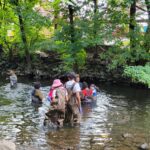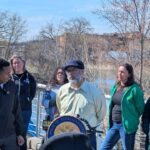A century after the depredations of Delancey’s Refugees, the Bronx River became the childhood home of an altogether different kind of cowboy.
Born in Newburgh, New York, Bill Hart had lived out west, where he was befriended by Sitting Bull (Tatanka Yotanka), learned the Lakota language, and acquired the Lakota name of Chanta Suta (Strong Heart.)
In the 1880s the young Hart returned east when his dad got a job as a mill stone dresser in West Farms, maintaining the grinding stones of the many water-powered mills that still clustered along the Bronx River. An avid outdoorsman, Hart would later fondly recall swimming in the Bronx River (there was a nice deep swimming hole opposite present-day Drew Gardens,) as well as ice skating when the river froze in the winter. As he grew into his teens, his first job was working on one of the ice wagons that sold ice harvested from the Bronx River.
After a successful career as a Shakespearian actor, Hart became the first cowboy star of the new silent movie industry, beginning in New York City and later moving out west. His life experiences enabled Hart to bring (and insist upon) an authentic portrayal of western life and, unusually for his time, a sympathetic portrayal of Native Americans, whom Hart occasionally played as well.
Sometimes called “the grandfather of all cowboy heroes,” Hart developed the classic character of the “good badman” throughout a 60-movie career ranging from “Hell’s Hinges” (1916) to “Tumbleweeds” (1925), retiring from the movies just before the dawn of the “talkies.” He numbered among his friends the artist Charlie Russell, Bat Masterson, and Wyatt Earp. But not everyone in Hollywood was his friend – after Buster Keaton produced a devastatingly precise satire of the long-faced, taciturn Hart, the cinematic cowboy refused to speak to him.
Stephen Paul DeVillo




